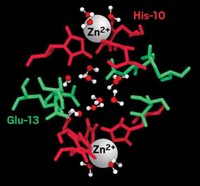Advertisement
Grab your lab coat. Let's get started
Welcome!
Welcome!
Create an account below to get 6 C&EN articles per month, receive newsletters and more - all free.
It seems this is your first time logging in online. Please enter the following information to continue.
As an ACS member you automatically get access to this site. All we need is few more details to create your reading experience.
Not you? Sign in with a different account.
Not you? Sign in with a different account.
ERROR 1
ERROR 1
ERROR 2
ERROR 2
ERROR 2
ERROR 2
ERROR 2
Password and Confirm password must match.
If you have an ACS member number, please enter it here so we can link this account to your membership. (optional)
ERROR 2
ACS values your privacy. By submitting your information, you are gaining access to C&EN and subscribing to our weekly newsletter. We use the information you provide to make your reading experience better, and we will never sell your data to third party members.
Biological Chemistry
One Helix’s Position May Determine Cell Signal Transmission
Computer simulations explain G-protein-coupled receptor’s signaling selectivity
by Carmen Drahl
August 4, 2014
| A version of this story appeared in
Volume 92, Issue 31
A tiny distance makes a big difference in how the signaling proteins known as G protein-coupled receptors (GPCRs) transmit messages, according to molecular dynamics simulations (J. Am. Chem. Soc. 2014, DOI: 10.1021/ja5055109). When biomolecules or drugs outside a cell bind membrane-spanning GPCRs, the proteins can activate any of several signaling partners inside the cell. Drugmakers want to activate the various partners at will. Wondering what drives partner selection, a team led by Peter W. Hildebrand of Berlin’s Charité University Hospital simulated the motions of the β2 adrenergic receptor, a GPCR, embedded in a lipid membrane. They included one of two peptides in the computational mix. Each peptide represented the portion of a G protein-signaling partner that contacts the GPCR. The team concludes that the GPCR’s sixth of seven transmembrane helices can orient itself in at least two stable positions, roughly 5 Å apart from one another. The bulkier of the two G protein peptides stabilizes the helix’s more open position, and the slimmer peptide stabilizes a more closed helix configuration. This corroborates what other teams observe in X-ray crystal structures and spectroscopic studies, the authors note.




Join the conversation
Contact the reporter
Submit a Letter to the Editor for publication
Engage with us on Twitter